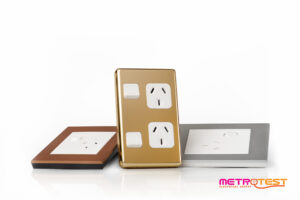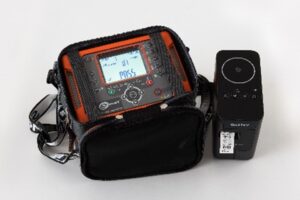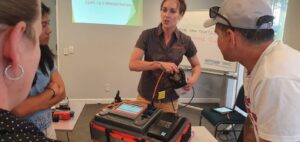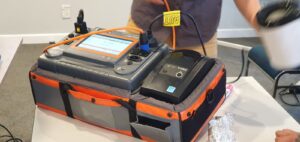
Are you looking for an effective way to test and tag your commercial workspace? Test and tag are critical aspects of workplace safety. It is essential to ensure that all electrical equipment is regularly tested and tagged to comply with safety regulations. In this blog article, we will discuss the essential requirements for commercial workspace testing, the types of tests required, and the safety precautions to take when testing and tagging your workspace.
What is Test and Tag?
Test and tag is a process that involves testing and tagging all electrical equipment in a commercial workspace to ensure that it is safe to use. This process is done by a qualified electrician or a technician who has been trained to carry out the necessary tests. The electrician will inspect all electrical equipment to make sure that it is safe to use and that it is in compliance with safety regulations.
The electrician will then tag the equipment with a label or tag that states that the equipment has been tested and is safe to use. This tag will typically include information such as the date it was tested and the expiry date of the test. Test and tag are critical elements of workplace safety. It is essential to ensure that all electrical equipment is regularly tested and tagged to comply with safety regulations.

Benefits of Test and Tag
There are many benefits of test and tagging your commercial workspace. Firstly, it ensures that all electrical equipment is safe to use and that it is in compliance with safety regulations. This can help to reduce the risk of accidents or injury in the workplace. Secondly, it helps to protect the equipment from damage due to electrical faults or surges. This ensures that the equipment is functioning correctly and that it is not at risk of breaking down. Finally, it can also help to reduce the risk of fires in the workplace due to electrical faults.
Essential Requirements for Commercial Workspace Testing
In order to ensure that all electrical equipment in your commercial workspace is safe to use, there are certain requirements that must be met. Firstly, all equipment must be tested by a qualified electrician or a technician who has been trained to carry out the necessary tests. This ensures that the equipment is safe to use and that it is in compliance with safety regulations.
Secondly, all equipment must be labeled or tagged with a label or tag that states that the equipment has been tested and is safe to use. This label or tag must include information such as the date it was tested and the expiry date of the test. Finally, it is essential to keep a record of all tests and tags carried out so that you can refer back to them if needed.
Types of Tests Required for Commercial Workspace
There are several different types of tests that must be carried out on electrical equipment in a commercial workspace. Firstly, a visual inspection must be carried out to check for any obvious signs of damage or faults. Secondly, an insulation resistance test must be carried out to ensure that the insulation between the live and neutral parts of the equipment is not compromised. Thirdly, a polarity test must be carried out to ensure that the equipment is correctly wired.
Finally, an earth continuity test must be carried out to ensure that the equipment is correctly earthed. Each type of test must be carried out by a qualified electrician or a technician who has been trained to carry out the necessary tests.

Test and Tag Equipment Checklist
When testing and tagging your commercial workspace, it is essential to have a checklist of all the equipment that needs to be tested. This will help to ensure that all equipment is tested and that no equipment is missed. The checklist should include all electrical equipment such as power tools, machines, lighting, and sockets. It should also include any extension leads or cables that are used in the workspace.
The checklist should also include information such as the type of test that needs to be performed on each piece of equipment, the date the equipment was tested, and the expiry date of the test. This information should be recorded in a logbook or on a spreadsheet so that it can be easily referred to.
How to Test Your Commercial Workspace
Once you have a checklist of all the equipment that needs to be tested, it is time to start the test and tag process. Firstly, the electrician or technician must carry out a visual inspection of the equipment to check for any signs of damage or faults. They may also need to use specialized testing equipment such as an insulation resistance tester or a polarity tester.
Once the tests have been carried out, the electrician or technician will then tag the equipment with a label or tag that states that the equipment has been tested and is safe to use. This label or tag will typically include information such as the date it was tested and the expiry date of the test.
Test and Tag Safety Precautions
When testing and tagging your commercial workspace, it is essential to take the necessary safety precautions. Firstly, the electrician or technician must make sure that they are wearing the appropriate safety equipment such as safety glasses, gloves, and ear protection. Secondly, they must ensure that all equipment is switched off and unplugged before they start testing. Finally, they must ensure that they are not working in wet or damp conditions as this could lead to electric shock.
Test and Tag Record Keeping
It is essential to keep a record of all tests and tags carried out in the commercial workspace. This record should include information such as the type of test that was performed, the date the equipment was tested, and the expiry date of the test. This information should be recorded in a logbook or on a spreadsheet so that it can be easily referred to.
This record should be kept up to date and any changes should be noted. This helps to ensure that all electrical equipment is safe to use and that it is in compliance with safety regulations.
Frequently Asked Questions about Test and Tag
Q: How often should electrical equipment be tested and tagged? A: Electrical equipment should be tested and tagged at least every 12 months or if there is any change in the equipment.
Q: What type of tests are required for a commercial workspace? A: The types of tests required for commercial workspace include visual inspection, insulation resistance test, polarity test, and earth continuity test.
Q: What safety precautions should be taken when testing and commercial tagging workspace? A: When testing and tagging commercial workspace, it is essential to take the necessary safety precautions such as wearing the appropriate safety equipment, switching off and unplugging the equipment, and avoiding wet or damp conditions.
Q: Do I need to keep a record of all tests and tags that have been carried out? A: Yes, it is essential to keep a record of all tests and tags that have been carried out in order to ensure that all electrical equipment is safe to use and that it is in compliance with safety regulations.

Conclusion
Test and tag are critical aspects of workplace safety. It is essential to ensure that all electrical equipment is regularly tested and tagged to comply with safety regulations. This blog article has discussed the essential requirements for commercial workspace testing, the types of tests required, the test and tag equipment checklist, how to test your commercial workspace, test and tag safety precautions, and test and tag record keeping.
Call Metro Test today and test and tag your commercial workspace! Test and tagging your commercial workspace is essential to ensure that all electrical equipment is safe to use and that it is in compliance with safety regulations.




















